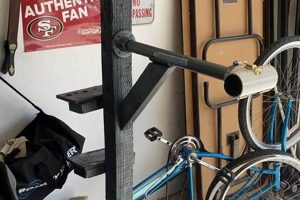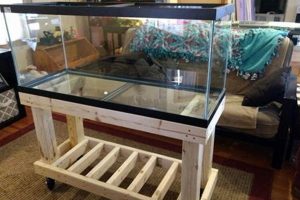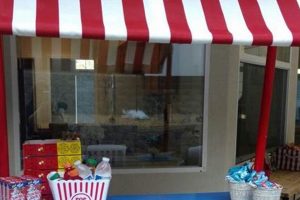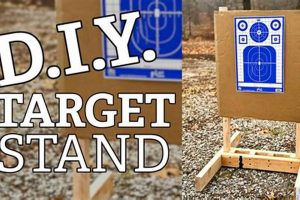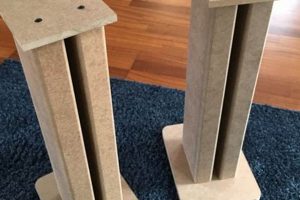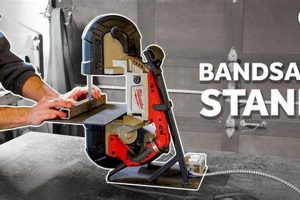The creation of a multi-tiered platform for displaying baked goods through do-it-yourself methods represents a cost-effective and personalized approach to presentation. For instance, individuals might repurpose existing materials like plates, candlesticks, or wooden rounds to construct a bespoke display piece.
Engaging in such a project offers benefits that extend beyond mere functionality. It allows for significant cost savings compared to purchasing commercially produced stands. Furthermore, the resulting structure can be tailored to specific aesthetic preferences, event themes, or size requirements. Historically, homemade display solutions have been common, reflecting a blend of resourcefulness and creative expression.
The subsequent sections will explore various materials suitable for construction, detail specific design considerations, and provide step-by-step instructions for building durable and visually appealing platforms. These instructions will cover different skill levels and material availability, enabling a broad range of individuals to successfully complete a personalized project.
Tips for Successful Construction
The following guidelines are intended to improve the structural integrity and aesthetic appeal of homemade platforms for displaying baked goods. Careful adherence to these recommendations can mitigate potential issues and enhance the final product.
Tip 1: Material Selection is Critical. Prioritize materials that are food-safe and structurally sound. Glass, wood treated with food-grade sealant, and certain plastics are appropriate choices. Avoid materials that may leach harmful chemicals or degrade under pressure.
Tip 2: Secure Adhesion is Essential. Employ adhesives specifically designed for the materials being joined. Epoxy resins or construction-grade adhesives generally provide superior bonding strength compared to general-purpose glues. Ensure proper curing time before loading the structure with weight.
Tip 3: Stability Testing is Mandatory. Before use, thoroughly test the assembled platform with a load exceeding the anticipated weight of the baked goods. This will identify any structural weaknesses or imbalances that require remediation.
Tip 4: Consider Weight Distribution. Design the platform to distribute weight evenly across all tiers. Overloading a single level can compromise stability and potentially lead to collapse. Wider bases provide increased stability.
Tip 5: Surface Finishing Enhances Durability. Applying a protective finish, such as paint or sealant, can improve resistance to moisture, stains, and physical damage. Choose finishes that are non-toxic and easy to clean.
Tip 6: Prioritize Accurate Measurement. Precise measurements are crucial for ensuring level tiers and a balanced overall structure. Utilize accurate measuring tools and double-check dimensions before cutting or assembling components.
Tip 7: Design for Disassembly (Optional). If storage space is limited, consider designing the platform for easy disassembly. This can be achieved through the use of threaded rods, wing nuts, or other removable fasteners.
Adhering to these guidelines will contribute to the creation of a stable, attractive, and long-lasting display solution for baked goods, while mitigating potential risks associated with structural failure or material incompatibility.
The subsequent concluding remarks will summarize the key benefits and emphasize the creative potential inherent in designing and constructing custom platforms for displaying baked goods.
1. Material Selection
The selection of materials for do-it-yourself display platforms is a foundational consideration, directly impacting both the structural integrity and aesthetic presentation of the final product. Careful deliberation is required to ensure stability, food safety, and visual harmony.
- Structural Load Capacity
The chosen materials must possess sufficient strength to support the combined weight of the platform itself and the baked goods it will hold. For instance, lightweight cardboard may be suitable for a single-tier display intended for a small number of items, but it would be inadequate for a multi-tiered structure designed to accommodate a large quantity. Examples of materials with high load-bearing capacity include hardwoods, metal, and certain reinforced plastics. Failure to consider load capacity can result in structural failure and potential damage to the displayed items.
- Food Safety Compliance
Materials in direct contact with food items must be non-toxic and resistant to bacterial growth. Untreated wood, for example, can harbor bacteria and should be sealed with a food-grade finish. Similarly, certain plastics may leach chemicals into food and are therefore unsuitable. Glass, stainless steel, and food-grade plastics are generally considered safe options. Neglecting food safety compliance can pose a health risk to consumers.
- Aesthetic Compatibility
The visual properties of the materials should complement the overall aesthetic of the event or presentation. For example, a rustic-themed event might benefit from the use of natural wood or reclaimed materials, while a modern event might call for sleek metal or glass. The color, texture, and finish of the materials should be carefully considered to create a cohesive and visually appealing display. Incompatibility between materials and the event theme can detract from the overall presentation.
- Durability and Longevity
The chosen materials should be resistant to wear and tear and capable of withstanding repeated use. Materials that are prone to moisture damage, scratching, or fading may require frequent replacement or maintenance. Durable materials such as metal, hardwood, or high-quality plastics can provide a longer lifespan for the display platform. Insufficient durability can lead to premature degradation and increased long-term costs.
In summary, material selection plays a critical role in the successful creation of a stable, safe, aesthetically pleasing, and durable display platform. A thorough assessment of structural requirements, food safety regulations, aesthetic preferences, and long-term durability is essential to ensure a satisfactory outcome. The careful consideration of these factors will contribute to a display solution that effectively showcases baked goods while maintaining both safety and visual appeal.
2. Structural Integrity
The relationship between structural integrity and do-it-yourself platforms for presenting baked goods is one of direct consequence. Insufficient structural integrity will inevitably lead to the collapse of the stand, resulting in potential damage to the displayed items, disruption of the event, and possible injury. This principle applies regardless of the aesthetic appeal or cost-effectiveness of the structure. A platform constructed from flimsy materials or lacking proper support will fail under the weight of the displayed items. For instance, a multi-tiered stand built using cardboard without adequate reinforcement will buckle, causing the cupcakes to fall. Thus, structural integrity is a non-negotiable element.
The design and construction should prioritize a stable base, appropriately sized tiers, and secure connections between the various components. Real-world examples highlight the importance of this consideration. A stand intended for a wedding, for example, requires robust construction to withstand the prolonged duration of the event and the weight of a significant number of cupcakes. The use of appropriate fasteners, such as screws or high-strength adhesives, is crucial for ensuring the stability of the connections. Similarly, the selection of materials with adequate load-bearing capacity, such as wood or metal, is essential for preventing structural failure.
In summary, the creation of do-it-yourself displays for baked goods mandates meticulous attention to structural integrity. The practical significance of this understanding lies in the prevention of catastrophic failures and the preservation of the intended aesthetic presentation. Overlooking this critical element undermines the entire project, regardless of other desirable attributes. A stable, well-constructed platform is the foundation upon which a successful display is built.
3. Aesthetic Customization
The creation of individualized display platforms for baked goods inherently invites aesthetic customization, allowing the structure to align with specific event themes, personal preferences, or branding strategies. The do-it-yourself nature of the process empowers individuals to exert direct control over the visual aspects of the final product, diverging from the limitations imposed by commercially available options. The cause-and-effect relationship dictates that deliberate aesthetic choices directly influence the perceived quality and overall impact of the presentation.
Aesthetic Customization is a critical component because it elevates the display from a mere functional object to a visual element that complements the baked goods and contributes to the ambiance of the occasion. For example, a rustic wedding might incorporate reclaimed wood and natural textures into the platform’s design, while a modern corporate event might favor sleek lines and metallic accents. The ability to select specific colors, materials, and decorative elements allows for a cohesive and impactful presentation. The absence of this element reduces the project to a purely utilitarian endeavor, diminishing the potential for visual engagement.
A deep understanding of aesthetic customization provides the opportunity to create displays that are not only functional but also contribute significantly to the overall event experience. Challenges may arise in balancing aesthetic aspirations with structural requirements and material availability. However, successful implementation requires careful planning, material selection, and a keen eye for detail. Ultimately, the ability to tailor the visual aspects of a display stand empowers individuals to create presentations that are both visually appealing and uniquely reflective of their personal style or brand identity.
4. Cost Effectiveness
The inherent connection between do-it-yourself platforms for displaying baked goods and cost-effectiveness stems from the reduction or elimination of retail markups and labor expenses associated with commercially produced alternatives. The creation of such stands utilizing readily available or repurposed materials offers a direct financial advantage. The cause-and-effect relationship is evident: engaging in self-construction reduces expenditure. The importance of cost-effectiveness as a component lies in the potential to allocate resources towards other aspects of an event or business, such as higher-quality ingredients or enhanced decorations.
Real-life examples substantiate this connection. An individual organizing a small gathering might construct a display using repurposed plates and candlesticks, incurring minimal expenses beyond adhesive. Conversely, purchasing a comparable tiered stand from a retail outlet would involve a significantly higher outlay. A small business owner could similarly benefit by crafting multiple stands for market displays, avoiding the recurring costs associated with renting or purchasing pre-made units. Furthermore, the do-it-yourself approach facilitates customization within a budget, allowing for tailored designs that might otherwise be financially prohibitive.
In summary, cost-effectiveness is a central driver for pursuing a do-it-yourself approach to display platforms. The practical significance of this understanding lies in the ability to achieve a desired aesthetic presentation without exceeding budgetary constraints. While challenges may include the time investment required for construction and the potential for material procurement costs, the overall financial benefits typically outweigh these considerations, making it an economically viable option for individuals and businesses alike. The relationship is a fundamental element when considering the creation of homemade display solutions.
5. Functionality Enhancement
Do-it-yourself projects for platforms designed to display baked goods offer a direct pathway to functionality enhancement, allowing creators to tailor the structure to specific needs beyond basic presentation. The capacity to integrate features not typically found in commercially available stands constitutes a primary benefit. The cause-and-effect relationship dictates that deliberate design choices directly expand the range of potential applications. The importance of functional enhancements lies in maximizing the utility and adaptability of the display, thereby increasing its long-term value and relevance.
Examples of functionality enhancement in such projects include adjustable tier heights to accommodate items of varying sizes, integrated lighting to highlight the baked goods, and the incorporation of carrying handles or detachable components for ease of transport and storage. A tiered stand designed for outdoor use, for example, could incorporate a rotating base to ensure even sun exposure or a protective covering to shield the displayed items from insects. Similarly, a stand intended for a professional bakery might include removable sections for simplified cleaning and sanitation. Furthermore, designing the platform to be collapsible when disassembled offers space-saving convenience during periods of non-use.
In summary, integrating functional enhancements into do-it-yourself platforms significantly expands their utility and applicability. The practical value of this understanding lies in the capacity to create display solutions that are precisely tailored to specific requirements, going beyond the limitations of standardized commercial products. Although challenges may involve increased design complexity and potential material costs, the resulting benefits in terms of adaptability, convenience, and overall utility make functionality enhancement a key consideration in the design and construction process. This approach ultimately transforms a simple display piece into a versatile and practical asset.
Frequently Asked Questions
The following questions address common inquiries and misconceptions surrounding the design, construction, and utilization of homemade display platforms for baked goods. The responses are intended to provide clear and concise information for individuals undertaking such projects.
Question 1: What are the primary considerations when selecting materials?
Material selection should prioritize structural integrity, food safety, and aesthetic compatibility. Materials must be capable of supporting the intended load, non-toxic if in contact with food, and visually appropriate for the intended setting.
Question 2: How can structural stability be ensured in a multi-tiered platform?
Structural stability relies on a firm base, appropriately sized tiers, and secure connections. Employ robust adhesives or mechanical fasteners appropriate for the materials being joined. Test the completed structure with a load exceeding the anticipated weight of the baked goods.
Question 3: What are the common failure points in do-it-yourself platforms?
Common failure points include inadequate adhesive bonds, insufficient load-bearing capacity of materials, and unbalanced weight distribution across tiers. Careful attention to these factors during design and construction is essential.
Question 4: Is sealing wood necessary for food safety?
Unsealed wood can harbor bacteria and is generally unsuitable for direct contact with food. Sealing with a food-grade sealant is recommended to create a barrier against moisture and bacterial growth. Verify that the chosen sealant is specifically approved for food contact.
Question 5: What are viable alternatives to traditional tiered stands?
Alternatives include repurposed cake stands, tiered serving platters, and custom-built structures utilizing materials such as wood, metal, or glass. The selection depends on the desired aesthetic and functional requirements.
Question 6: How can the platform be effectively cleaned and sanitized?
Cleaning and sanitation protocols should be tailored to the specific materials used. Smooth, non-porous surfaces are generally easier to clean. Employ appropriate cleaning agents and disinfectants, ensuring thorough rinsing and drying to prevent contamination.
These FAQs address core aspects of designing and constructing do-it-yourself platforms. Careful consideration of these elements will improve the likelihood of creating a safe, stable, and aesthetically pleasing display for baked goods.
The subsequent concluding remarks will summarize the key benefits and emphasize the creative potential inherent in designing and constructing custom platforms for displaying baked goods.
Concluding Remarks on Cupcake Stand DIY
This exploration has underscored that constructing display platforms, through cupcake stand diy, offers a multifaceted approach to presentation. Key benefits include cost savings, customization potential, and the opportunity to enhance functionality. Material selection, structural integrity, aesthetic alignment, and food safety remain critical considerations throughout the design and construction process.
The significance of cupcake stand diy extends beyond mere practicality; it represents a tangible expression of creativity and resourcefulness. Successful implementation relies on informed decision-making and attention to detail. Therefore, individuals are encouraged to approach these projects with a focus on both aesthetic appeal and structural soundness, ensuring the creation of display solutions that are both visually engaging and functionally reliable.


